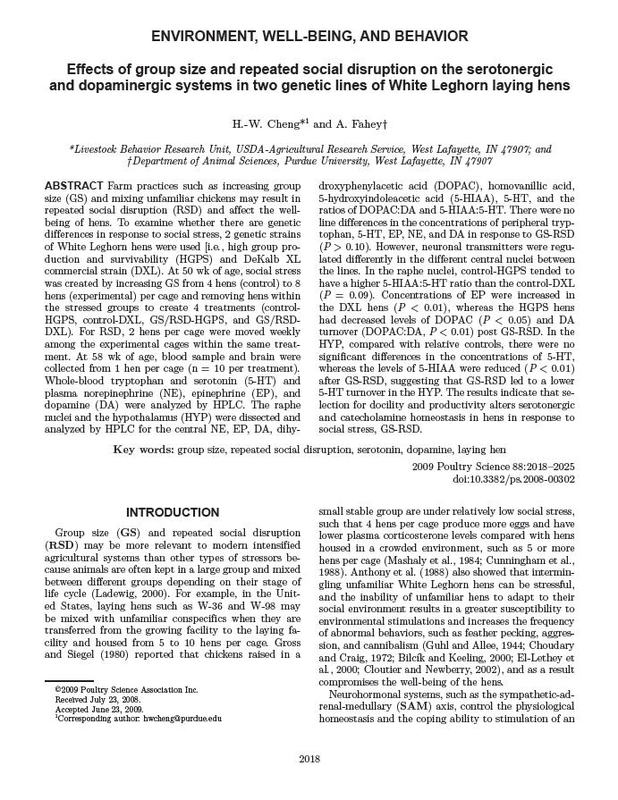Effects of group size and repeated social disruption on the serotonergic and dopaminergic systems in two genetic lines of White Leghorn laying hens
Title
Effects of group size and repeated social disruption on the serotonergic and dopaminergic systems in two genetic lines of White Leghorn laying hens
Date
Subject
Excerpt
Farm practices such as increasing group size (GS) and mixing unfamiliar chickens may result in repeated social disruption (RSD) and affect the well-being of hens. To examine whether there are genetic differences in response to social stress, 2 genetic strains of White Leghorn hens were used [i.e., high group production and survivability (HGPS) and DeKalb XL commercial strain (DXL). At 50 wk of age, social stress was created by increasing GS from 4 hens (control) to 8 hens (experimental) per cage and removing hens within the stressed groups to create 4 treatments (control-HGPS, control-DXL, GS/RSD-HGPS, and GS/RSD-DXL). For RSD, 2 hens per cage were moved weekly among the experimental cages within the same treatment. At 58 wk of age, blood sample and brain were collected from 1 hen per cage (n = 10 per treatment). Whole-blood tryptophan and serotonin (5-HT) and plasma norepinephrine (NE), epinephrine (EP), and dopamine (DA) were analyzed by HPLC. The raphe nuclei and the hypothalamus (HYP) were dissected and analyzed by HPLC for the central NE, EP, DA, dihydroxyphenylacetic acid (DOPAC), homovanillic acid, 5-hydroxyindoleacetic acid (5-HIAA), 5-HT, and the ratios of DOPAC:DA and 5-HIAA:5-HT. There were no line differences in the concentrations of peripheral tryptophan, 5-HT, EP, NE, and DA in response to GS-RSD (P > 0.10). However, neuronal transmitters were regulated differently in the different central nuclei between the lines. In the raphe nuclei, control-HGPS tended to have a higher 5-HIAA:5-HT ratio than the control-DXL (P = 0.09). Concentrations of EP were increased in the DXL hens (P < 0.01), whereas the HGPS hens had decreased levels of DOPAC (P < 0.05) and DA turnover (DOPAC:DA, P < 0.01) post GS-RSD. In the HYP, compared with relative controls, there were no significant differences in the concentrations of 5-HT, whereas the levels of 5-HIAA were reduced (P < 0.01) after GS-RSD, suggesting that GS-RSD led to a lower 5-HT turnover in the HYP. The results indicate that selection for docility and productivity alters serotonergic and catecholamine homeostasis in hens in response to social stress, GS-RSD.
Relation
Poultry Science
Volume 88, Number 10
pp. 2018-2025
 An official website of the United States government.
An official website of the United States government.


